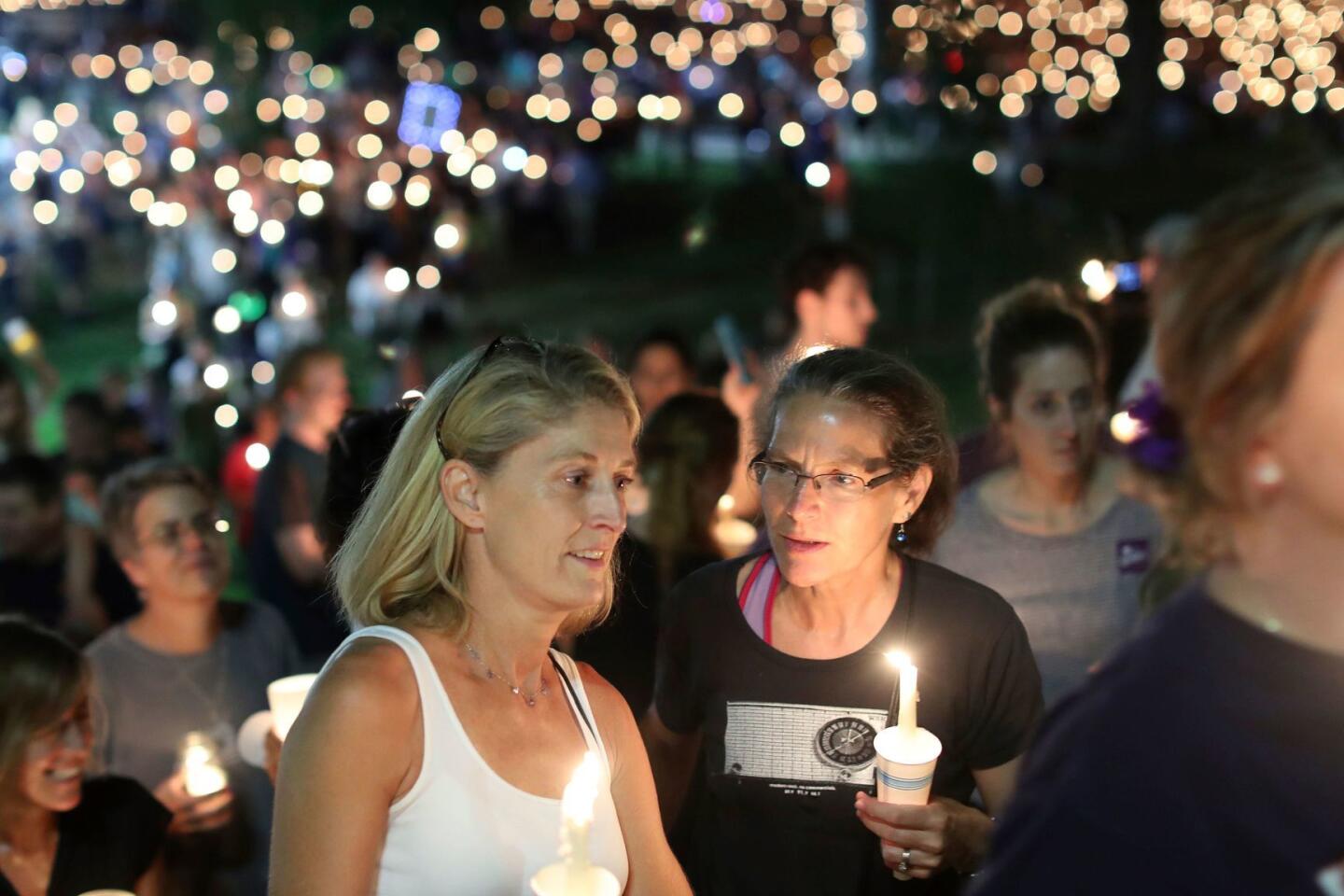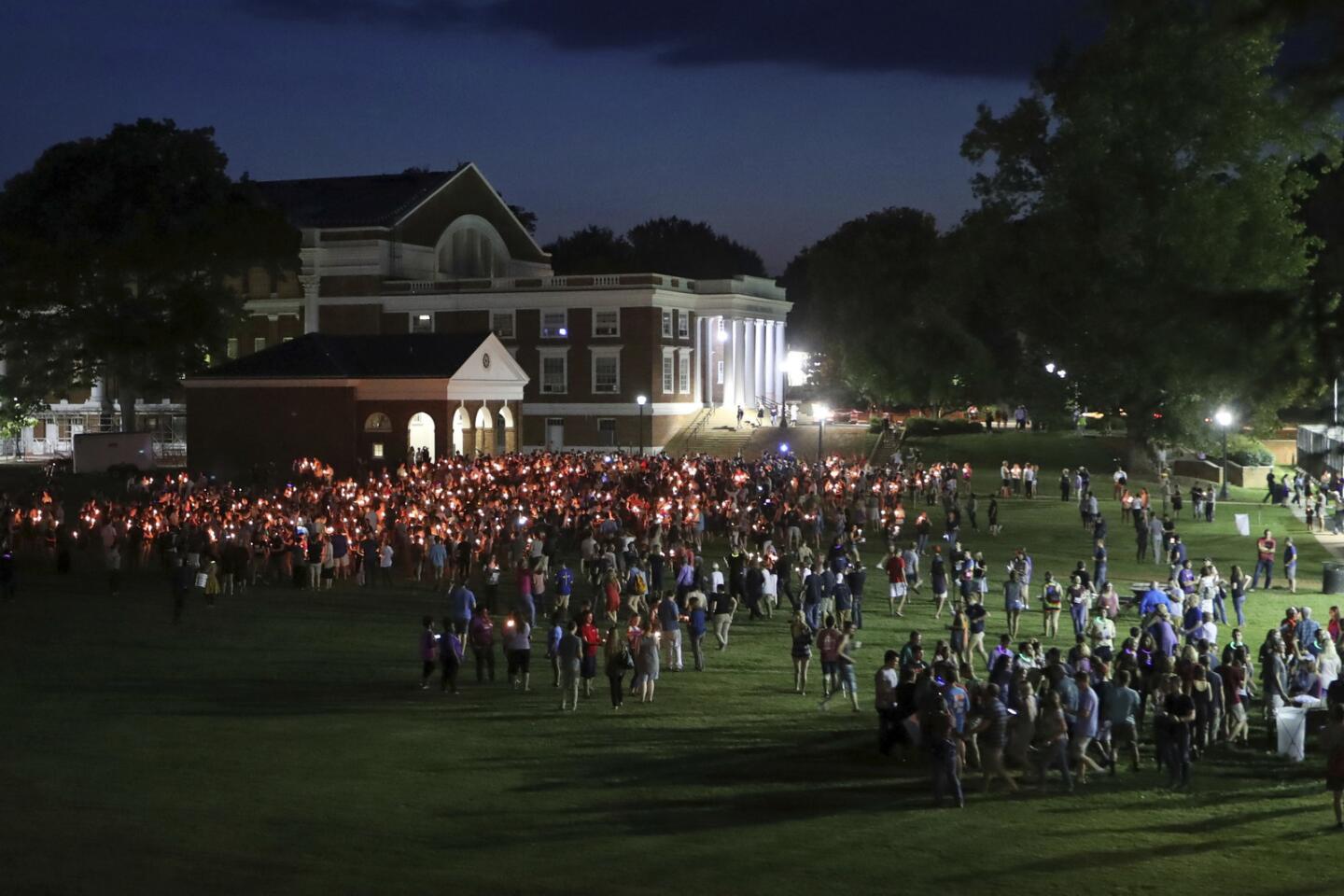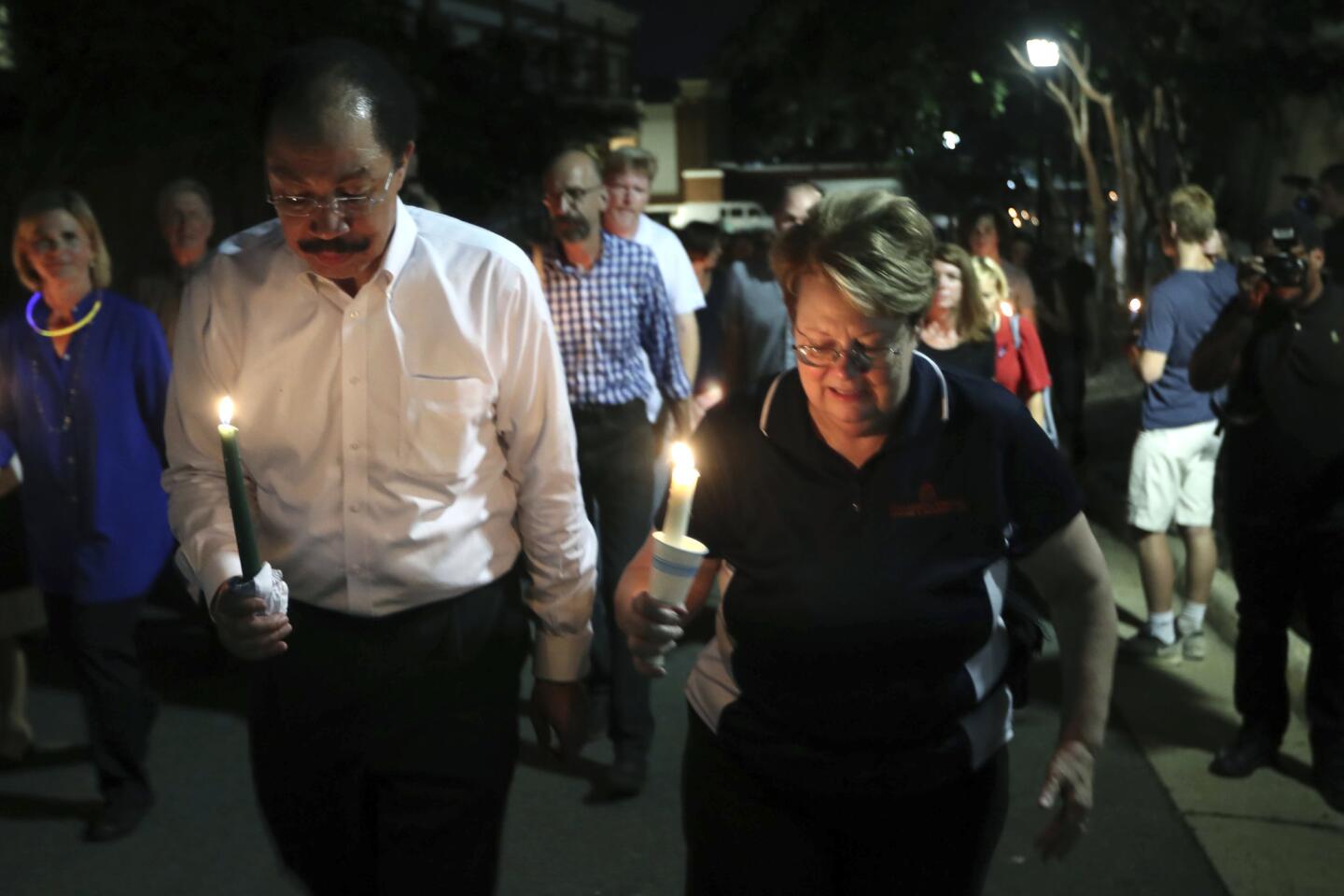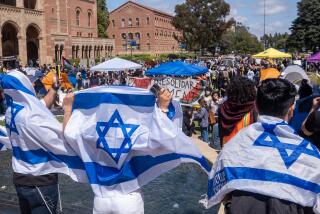Thousands march in Charlottesville against racism and violence
- Share via
Reporting from CHARLOTTESVILLE, VA. — Declaring their resolve to “take back the Lawn,” students and faculty descended by the thousands on the University of Virginia as night fell Wednesday. Holding candles, laughing and singing softly, they retraced the steps taken less than a week ago by demonstrators clutching tiki torches and chanting Nazi-era slogans.
The event, organized by a coalition of students and administrators but cloaked in secrecy for security reasons until hours before, culminated before the steps of the school’s domed Rotunda at the center of campus.
Student Joy Collins addressed the crowd, as many as 4,000 strong, and gave a stirring reading of Maya Angelou’s poem “Still I Rise,” which ends:
I am the dream and the hope of the slave.
I rise
I rise
I rise.
Then Collins offered a brief message.
“Thank you for bringing peace to our grounds,” she said. “And as we depart today, we hope that you carry peace in your hearts.”
The vigil came after days of confrontation, tragedy and healing in this college town. Far-right rallies last weekend left three people dead and dozens injured, including students and community members who came to blows with neo-Nazis at the foot of the Rotunda, following the torch-lit march Friday night.
These kind of rituals are so important. It feels empowering; we are connected again. We’ve blessed this place again.
— John Alexander, University of Virginia faculty member
As Wednesday night’s crowd dispersed, many made their way around the Rotunda, the stately building designed by university founder Thomas Jefferson, and gathered at a statue of Jefferson.
“Whose town?” the people chanted. “Our town!”
A sign saying “Resist” had been laid at the statue’s pedestal, right where the fighting happened.
That confrontation, as it turned out, was only a prelude to the chaos that engulfed the downtown area of the city on Saturday, when after violent clashes between far-right rally-goers and counter-protesters, a man who police said had Nazi sympathies drove a car through a crowd of activists, killing a 32-year-old woman and leaving 19 others hospitalized.
Two state troopers patrolling the skies over the mayhem died in a helicopter crash.
On Wednesday morning, hundreds of city residents gathered on the downtown pedestrian mall for a memorial service for Heather Heyer, the local woman who was killed.
The night before, faculty and students — many of whom were just beginning to filter back to campus for the start of the fall semester — had begun receiving word, in text messages and on private mailing lists, that something much bigger was being planned at the university.
“Tonight is all about bringing the community together and trying to start to heal — to focus on our spiritual well-being and move forward,” said Wes Gobar, president of the university’s Black Student Alliance, emphasizing the symbolism of candles and the solemnity of the procession.
“Torches have a particular history — a history of being used in lynchings and KKK rallies — and they knew that,” Gobar said. “This is a totally different tone.”
The gathering began to form about 8 p.m. on so-called Nameless Field, behind an old campus gymnasium. As the crowd swelled in the darkness, points of light lit up the field, and organizers wearing glow-sticks passed out candles and helped people light them.
Just after 9 p.m. the crowd began moving: behind the school’s library, around the student center and eventually to the Rotunda. Members of the football team formed one big column and lumbered forward, helping lead the way.
The crowd passed through the middle of the university’s Academical Village, with its white columns, low brick buildings and grassy, tree-lined Lawn, a place steeped in history.
It was here, in the 19th century, that enslaved laborers had a hand in constructing the buildings and gardens that surround them. It was here, in the 1960s, that civil rights and antiwar marches were held. And it was near here, in 2012, that a handful of students staged a hunger strike in support of a living wage for some university workers, many of them descendants of slaves.
That effort failed. But another mass demonstration later that year — demanding that fired university President Teresa Sullivan be reinstated — succeeded. And this time around, the administration played a crucial role in coordinating events.
University officials said they kept information about the gathering quiet out of fear that the far right might hear about it and cause a disturbance, or worse. But this night proceeded in peace, even a kind of serenity.
“It’s inspiring,” said John Alexander, a faculty member who works in the library. “These kind of rituals are so important. It feels empowering; we are connected again. We’ve blessed this place again.”
Alexander had been among a group temporarily penned up inside a church near Friday’s battle, a moment he called terrorizing, especially for the African Americans attending the service, which was set up specifically in response to the far-right demonstrators and their notorious leader Richard Spencer, a University of Virginia alumnus.
There has been some dissension on campus, however. Some students and faculty have argued that the university administration has not spoken out forcefully enough against what transpired. But such divisions seemed overshadowed Wednesday night by a sense of resolve.
The vigil was a startling contrast to the scene Friday when hundreds gathered for the “Unite the Right” march. Marchers angrily chanted “Blood and soil!” and “Jews will not replace us!” as they stomped through the campus, torches held high.
The protesters also marched down the Lawn and gathered around the statue of Jefferson to chant, “White lives matter!”
On Wednesday night, the crowd sang softly — “I’m Gonna Let it Shine,” “We Shall Overcome” and “This Land is Your Land” — and swayed from side to side. At times there was no singing and no speeches. Thousands of people — men and women, young and old, black and white — stood together in the summer night quietly holding their candles.
Armengol is a special correspondent.
ALSO
Joint Chiefs denounce racism in stark terms as Trump’s isolation grows
Trump’s defense of a neo-Nazi rally crossed a line for many Republicans. What will they do about it?
UPDATES:
10:05 p.m.: The article was updated with additional background on the University of Virginia.
The article was originally published at 9 p.m.
More to Read
Sign up for Essential California
The most important California stories and recommendations in your inbox every morning.
You may occasionally receive promotional content from the Los Angeles Times.















